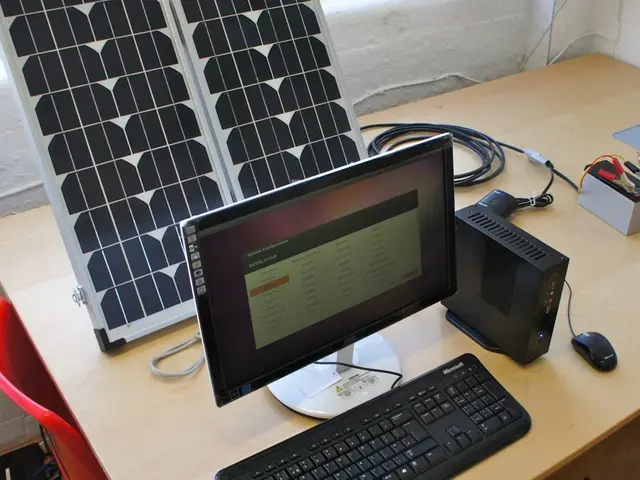Approximately one-tenth of the United States' electricity demand could potentially be met by geothermal energy, according to the United States Geological Survey (USGS).
New Article:
Tapping into a Hidden Power Source: Geothermal Energy in the Great Basin
The US is sitting on a golden opportunity to significantly bolster its electricity supply, according to a new report from the US Geological Survey (USGS). The secret lies beneath the Earth's surface - geothermal energy, the natural heat simmering within the Earth. Although the US has already tapped into this energy source, it accounts for less than 1% of the nation’s electricity.
The updated assessment of a 2008 study by the USGS suggests that geothermal resources in Nevada's Great Basin and surrounding areas could generate electricity equivalent to 10% of the country's current power supply. That's a major increase from the current production. However, practical challenges exist before the nation can tap into this power source. Most geothermal power comes from hydrothermal systems, where underground water naturally heats due to hot rocks below the surface. Visible signs of this process include steaming vents, hot springs, and geysers.
Yet, much larger reserves of thermal energy are locked deeper within impermeable, dry rock layers. Tapping into this heat requires enhanced geothermal systems, a process that involves drilling over 6 kilometers (3.7 miles) underground to create pathways that allow water to circulate, absorb heat, and return the energy to the surface to produce electricity. This is similar to creating human-made hydrothermal systems.
While the technology to achieve this has been around for decades, many countries have been exploring its possibilities. The USGS report suggests that the time may be right for the US to scale up its own enhanced geothermal systems, and the Great Basin stands out as a prime candidate for expansion.
To gauge the potential energy resources in the Great Basin, USGS scientists used underground temperature maps, heat flow measurements, and advanced modeling techniques to assess how efficiently heat could be extracted and converted into electricity. Sarah Ryker, acting director of the USGS, stated, "We focus on undiscovered resources that have yet to be fully explored, let alone developed. We launched this work in the Great Basin because of the area's history of geothermal activity - and we found even more potential for baseload power than had previously been known."
The potential benefits of enhancing geothermal systems in the Great Basin are numerous. They offer a substantial energy potential – enough to supply up to 10% of the U.S. electricity demand, baseload reliability, technological advancement, reduction in carbon emissions, and economic growth. These benefits, however, come with some risks.
Despite the alluring rewards, unlocking these benefits will require balancing innovation with serious caution. One concern is the risk of induced seismicity, similar to fracking for oil, as this process involves pumping water deep underground, increasing the likelihood of triggering earthquakes. While most induced seismic events are minor, larger, damaging earthquakes are a risk that regulators and developers must mitigate.
Other concerns include environmental impact on wildlife, water use and management, regulatory and approval challenges, and uncertainty with emerging technologies. Balancing these risks with the potential benefits will be crucial for sustainable development and harnessing the full promise of geothermal energy in the Great Basin.
Following their assessment of the Great Basin, researchers will now shift focus to the Williston Basin in North Dakota.
Enrichment Data:
- Substantial Energy Potential: Could supply up to 10% of U.S. electricity demand[1][3][5]
- Baseload Reliability: Continuous, weather-independent power[5]
- Technological Advancement: Innovations like AI and machine learning improving efficiency[1][5]
- Lower Emissions: Cleaner than fossil fuels, supports climate goals[2][5]
- Economic Growth: Creates jobs and investment opportunities[4]
- Induced Seismicity: Risk of triggering earthquakes through rock fracturing[1]
- Wildlife Impact: Disruption of habitats, e.g., sage-grouse[2]
- Water Resource Issues: High water use for EGS operations[1][2]
- Regulatory/Community Pushback: Opposition from locals, environmental groups, and regulatory delays[2][4]
- Technology Uncertainty: Success dependent on further development and deployment[1][5]
In conclusion, enhancing geothermal systems in the Great Basin offers a golden opportunity to significantly boost U.S. clean energy supply and improve grid reliability, but this comes with environmental and technical challenges that must be carefully managed to ensure sustainable development.
- The Great Basin's enhanced geothermal systems hold the potential to supply up to 10% of the U.S.'s electricity demand, offering a substantial energy potential.
- Advancements in technology, such as artificial intelligence and machine learning, are improving the efficiency of geothermal systems, contributing to technological advancement.
- While unlocking this energy potential offers benefits like baseload reliability, lower emissions, and economic growth, it also presents risks such as induced seismicity, wildlife impact, water resource issues, regulatory challenges, and technology uncertainty.
- In the Williston Basin, North Dakota, researchers will now focus their efforts, following their assessment of the Great Basin.
- The balance between innovation and caution will be crucial for sustainable development and harnessing the full promise of geothermal energy, while considering the concerns associated with environmental science, the industry, finance, and energy.







